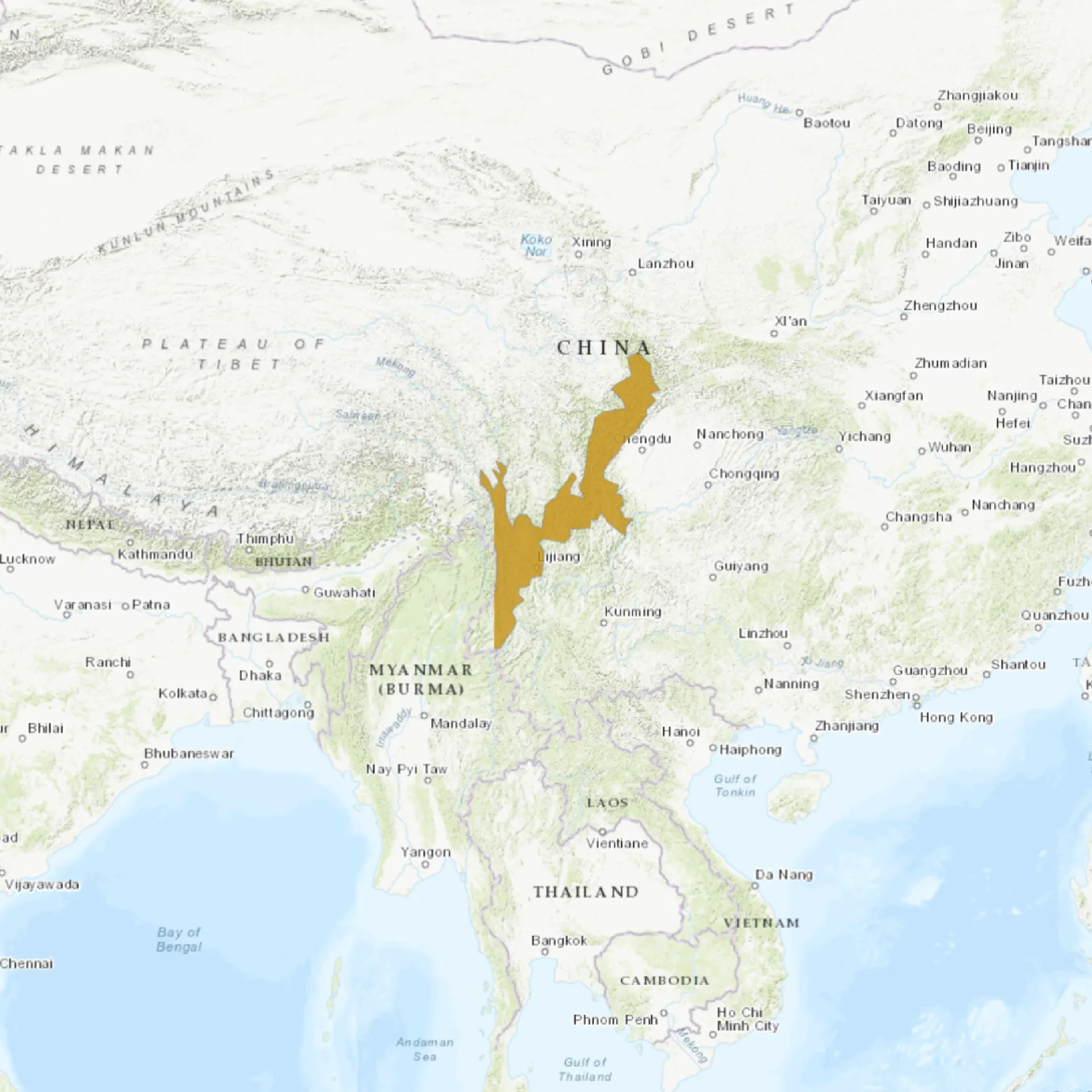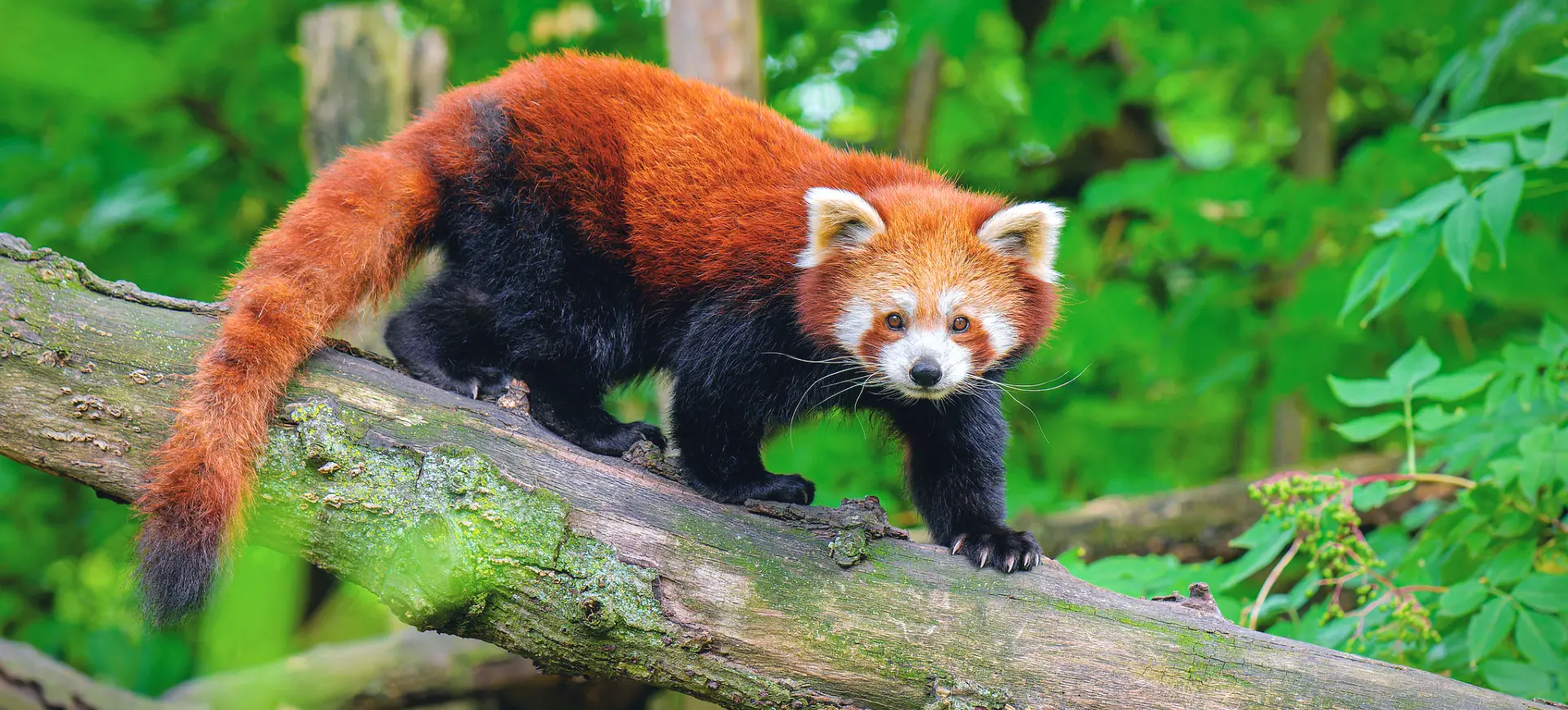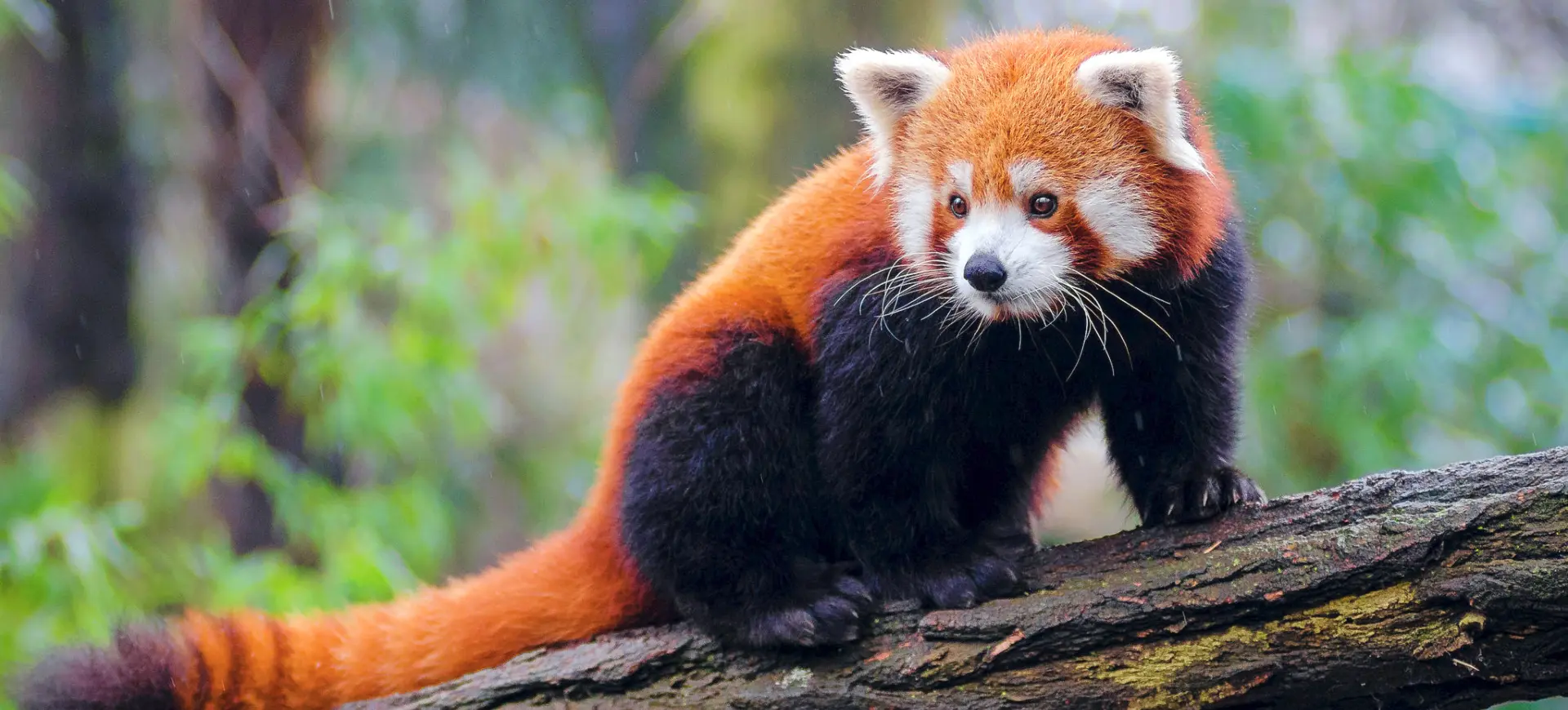Overview
The Chinese red panda (Ailurus fulgens styani), also known as Styan’s red panda, is a subspecies of the red panda native to the eastern Himalayas and southwestern China. It is distinguished from the Himalayan red panda by its larger size, denser fur, and more pronounced facial markings. This arboreal and primarily crepuscular mammal is known for its agility in trees, where it spends much time foraging and resting. Despite its name, the Chinese red panda is not closely related to giant pandas but belongs to its family, Ailuridae.
This species has a thick reddish-brown coat that provides insulation against cold mountain temperatures, along with a bushy tail used for balance and warmth. The face features white markings and dark “tear tracks” running from the eyes to the mouth, which may help reduce glare and aid in camouflage. Chinese red pandas have a pseudo-thumb, an extended wrist bone that helps them grasp bamboo stalks, their primary food source. Their body structure is adapted for climbing, with strong, curved claws and flexible ankles that allow them to descend trees headfirst.
Chinese red pandas are solitary in the wild, except during mating season and when mothers are raising cubs. They are primarily herbivorous, with bamboo comprising most of their diet, though they consume fruits, berries, flowers, and occasionally small animals. Due to habitat destruction and fragmentation, their populations are declining, leading to conservation efforts aimed at habitat preservation and anti-poaching measures. Climate change also affects their bamboo food sources, making conservation efforts increasingly urgent.
Taxonomy
Kingdom
Phylum
Class
Order
Family
Genus
Species
Sub Species
Type
Current distribution:
Chinese red pandas are native to the eastern Himalayan region, with populations concentrated in southwestern China and northern Myanmar. They are most commonly found in Sichuan and Yunnan provinces, where large tracts of temperate forest support bamboo growth. Though their range overlaps with the Himalayan red panda (Ailurus fulgens fulgens), genetic studies suggest significant differences between the subspecies. Due to their elusive and nocturnal nature, they are rarely seen in the wild.
Their distribution is increasingly fragmented due to deforestation, road construction, and agricultural expansion. Protected areas and national parks in China, such as Wolong Nature Reserve, play a crucial role in their conservation. Some populations exist in Myanmar, though their status remains poorly studied. Climate change is also shifting bamboo growth patterns, further altering their distribution.
Physical Description:
The Chinese red panda has a dense, soft coat that ranges from deep red to orange-brown on the upper body and black on the underside. Its face has distinctive white markings, including a mask-like pattern and light rings around the ears. The long, bushy tail is covered in alternating light and dark rings, providing balance and camouflage among tree branches. Its legs are short and powerful, ending in sharp, semi-retractable claws adapted for gripping tree bark and bamboo stems.
This subspecies is slightly larger than the Himalayan red panda, with a more robust build and thicker fur suited for colder climates. Its head is rounded with a short snout, small pointed ears, and dark eyes that enhance night vision. The pseudo-thumb, an extension of the wrist bone, is a crucial adaptation that allows the panda to grasp and manipulate food efficiently. Its hind legs have a unique rotating ankle joint, enabling it to climb down trees headfirst, an uncommon trait among arboreal mammals.

Lifespan: Wild: ~8 Years || Captivity: ~15 Years

Weight: Male: 10–14 lbs (4.5–6.5 kg) || Female: 6.6–13 lbs (3–6 kg)

Length: Male: 22–25.6 in (56–65 cm) || Female: 20.5–23.6 in (52–60 cm)

Top Speed: 24 mph (38 km/h)
Characteristic:
Native Habitat:
Chinese red pandas are found in temperate mountain forests, where they prefer dense bamboo understories within mixed broadleaf and coniferous forests. They thrive at elevations ranging from 4,900 to 13,000 feet (1,500 to 4,000 meters), where temperatures remain cool and humidity is high. These habitats provide abundant bamboo growth, essential for their survival, and tree cover for shelter and protection from predators. They are most commonly found in southwestern China, particularly in Sichuan and Yunnan provinces.
Their arboreal nature makes them dependent on forests with old-growth trees that offer nesting sites in tree hollows. During the day, they rest in branches or tree cavities to avoid extreme temperatures and conserve energy. These pandas are highly sensitive to habitat disturbance, and deforestation can severely impact their food supply and shelter availability. They require large, contiguous forest areas for sustainable populations, as habitat fragmentation isolates groups and reduces genetic diversity.
Biomes:
Biogeographical Realms:
Continents:
Diet:
Diet & Feeding Habits:
Chinese red pandas are primarily herbivorous, with bamboo making up around 85–95% of their diet. They consume bamboo leaves, shoots, and stems, preferring young and tender growths that are easier to digest. Due to bamboo’s low nutritional value, they must eat large quantities daily and spend much of their active time foraging. Unlike giant pandas, they occasionally supplement their diet with fruits, berries, mushrooms, insects, and small vertebrates.
These animals have a slow metabolism adapted to a diet high in fibrous plant material. Their digestive system lacks the specialized enzymes to break down cellulose efficiently, making digestion relatively inefficient. They have a long gut retention time and select the most nutritious bamboo parts to compensate. They also exhibit seasonal dietary variations, consuming more fruits and protein sources when available.
Mating Behavior:
Mating Description:
Chinese red pandas are generally solitary, coming together only during the breeding season. Males and females communicate through scent markings and vocalizations to locate each other for mating. The gestation lasts about 134 days, after which the female gives birth to one to four cubs in a tree hollow or rocky crevice. Cubs are born blind and helpless, relying entirely on their mother for warmth and nourishment.
The mother raises the young alone, providing milk and grooming them for several months. Cubs begin to explore their surroundings at around three months but remain dependent on their mother for up to a year. Mating season typically occurs between January and March, aligning with seasonal bamboo growth. Males do not participate in parental care and resume their solitary lifestyle after mating.
Reproduction Season:
Birth Type:
Pregnancy Duration:
Female Name:
Male Name:
Baby Name:
Social Structure Description:
Chinese red pandas are primarily solitary animals, with individuals maintaining distinct home ranges that they mark using scent glands, urine, and feces. Males typically have larger territories that may overlap with those of multiple females, though they avoid direct interactions outside of the breeding season. They are most active during dawn and dusk (crepuscular behavior), spending much time foraging alone in trees or on the forest floor. They communicate through body postures, vocalizations like whistles and huff-quacks, and scent markings when encounters occur.
During the mating season, temporary pair bonds may form, but males do not assist in raising the young. Mothers are solely responsible for caring for their cubs, providing them with milk, grooming, and protection inside tree hollows or rock crevices. Cubs remain with their mother for up to a year before becoming independent and dispersing to establish their territories. While generally solitary, red pandas may tolerate others in overlapping territories with abundant food sources, though direct social interactions remain rare.
Groups:
Conservation Status:
Population Trend:
The Chinese red panda population is estimated to be fewer than 10,000 individuals in the wild, with numbers continuing to decline due to habitat loss and fragmentation. Genetic studies indicate that this subspecies is distinct from the Himalayan red panda, with limited interbreeding due to geographical separation. Small, isolated populations exist within protected reserves, but their long-term viability is uncertain without habitat connectivity. Captive breeding programs in zoos and conservation centers aim to maintain genetic diversity and provide individuals with potential reintroduction efforts.
Population density varies based on habitat quality, with higher numbers found in well-preserved forests with abundant bamboo. However, habitat fragmentation forces some groups into suboptimal areas, reducing access to food and increasing vulnerability to human activities. Conservation efforts in China, including reforestation projects and protected areas like the Wolong Nature Reserve, have helped stabilize some populations. The species remains endangered despite these efforts, requiring continued intervention to prevent further declines.
Population Threats:
Habitat destruction is the most significant threat to Chinese red panda populations, primarily due to deforestation for agriculture, logging, and infrastructure development. Expanding human settlements and road construction further fragment their habitat, isolating populations and reducing genetic diversity. The loss of bamboo forests directly impacts their primary food source, leading to malnutrition and decreased reproductive success. Additionally, climate change is altering bamboo growth patterns, making food availability unpredictable.
Poaching and illegal wildlife trade also contribute to population decline, as red pandas are sometimes captured for their fur or sold as exotic pets. Although they are legally protected in China, enforcement of anti-poaching laws remains inconsistent, allowing illegal activities to persist. Competition with livestock for food and space also poses a challenge, as domestic animals can degrade bamboo forests and introduce diseases. Additionally, predation by natural predators like snow leopards and martens, combined with human-related threats, further endangers their survival.
Conservation Efforts:
The Chinese red panda is legally protected under Chinese wildlife conservation laws, and several national parks and reserves, such as the Wolong Nature Reserve and Gaoligongshan National Nature Reserve, have been established to safeguard its habitat. Conservation organizations, including the Red Panda Network and World Wildlife Fund (WWF), work to restore forested areas, combat poaching, and raise awareness about the species’ plight. Captive breeding programs in zoos worldwide play a crucial role in maintaining genetic diversity and may provide individuals for future reintroduction programs. Research initiatives focus on monitoring wild populations, studying habitat requirements, and identifying key threats to inform better conservation strategies.
Efforts to reduce habitat fragmentation include reforestation projects and the establishment of wildlife corridors to reconnect isolated populations. Local community engagement programs educate people on the ecological importance of red pandas and promote sustainable land-use practices. Anti-poaching patrols and stricter enforcement of wildlife protection laws aim to reduce illegal hunting and pet trade activities. Ongoing climate change mitigation strategies focus on preserving bamboo forests, as shifting temperatures and rainfall patterns threaten the species’ primary food source.
Additional Resources:
Fun Facts
- The Chinese red panda tends to be larger and fluffier than the Himalayan red panda and has more distinct facial markings.
- Despite being classified in the order Carnivora, it primarily eats bamboo, making it functionally herbivorous.
- It has a “pseudo-thumb,” an extended wrist bone that helps it grasp bamboo, similar to the giant panda.
- Red pandas were discovered before the giant pandas and were the first animals called “pandas.”
- Their thick, bushy tails help them balance in trees and also serve as blankets in cold weather.
- They can climb down trees headfirst thanks to a rotating ankle joint, a rare adaptation among arboreal mammals.
- Red pandas communicate using whistles, twitters, “huff-quacks,” and scent markings.
- Their fur is highly water-resistant, allowing them to stay dry in their misty mountain habitat.
- Cubs are born blind and develop their characteristic red fur as they grow.
- The scientific name Ailurus fulgens means “shining cat,” reflecting their cat-like agility and vibrant coat.











